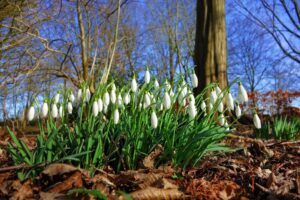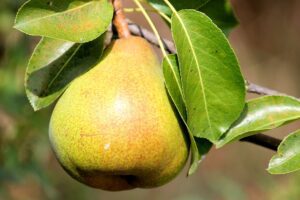
March seems to be the anticipation month. March gives us Daylight Savings Time, St. Patrick’s Day and the best of days – MARCH 20th, THE FIRST DAY OF SPRING! We’re about to be very busy! Where to begin?
- Monitor and Planning–As you walk around your garden make a list of jobs to be completed. Look for damage to trees, evergreens and shrubs from snow, animals or pests. If you’ve ordered plants decide where they will be placed.

- Seed Starting–Organize your seeds; decide which to start indoors and which can be direct sown. Broccoli, cauliflower, Brussel sprouts and cabbage are among those that can be started indoors early. Determine the last frost date and refer to the seed calculator (see Sandi’s President’s Points) to know when to plant. Make sure your equipment is clean. If you use older seeds check for viability. Many of your seeds will be started by the end of the month.
- Indoor Plants–Organize plants which will go back into your garden. Keep monitoring for diseases. Pot up caladium and tuberous begonias for summer color.
- Winter Pruning–Complete your winter pruning before trees, evergreens and shrubs start showing new buds. Make sure your tools are sharp, protect your fingers and eyes and clean tools frequently so diseases aren’t spread. Follow the Winter Pruning Hints in the February Newsletter.
- Birds and Wildlife–Continue to provide food and water for birds and wildlife.
- Garden Bed Preparation–Don’t work the soil if it’s too wet. Walking on wet garden beds will only compress the soil and make it harder to work later. Soil should feel like crumbly cake in your

- Perennials and Bulbs–If perennials have heaved out of the ground plant back into the soil. Don’t uncover garden beds until you are sure the frost has passed. Make sure bulbs are uncovered enough to grow. You will know bulbs aren’t getting enough light if the base is yellow instead of green. If you haven’t already done so, this is the time to cut back last year’s dead leaves and branches. Old Hellebore leaves can be cut back so new leaves and blooms can be seen. Remove dead leaves from asparagus and rhubarb. If you’ve received live plants put them in a cold frame or bring them indoors if the weather is too cold.
- Fertilizing and Rototilling–When soil is workable rototill garden beds to incorporate compost, composted manure and fertilizer. Fertilize garden beds with 6-12-12 fertilizer and vegetable
beds with 12-12-12 fertilizer. Asparagus and rhubarb may need nitrogen fertilizer around the base to stay healthy. - Lawns–Grass seeds grow best in cool weather. Some suggest sowing them on the last vestiges of snow allowing them to settle into the ground as it melts.
- Fruit Trees–Apply a dormant oil spray to your fruit trees before the buds break to help control insects. Make sure the temperatures are above 32 degrees and remain above freezing for 24 hours after spraying.

- Trees and Shrubs–Fertilize trees and shrubs just before they begin spring growth. Dig trees and shrubs for planting or transplanting as soon as the soil can be worked.
